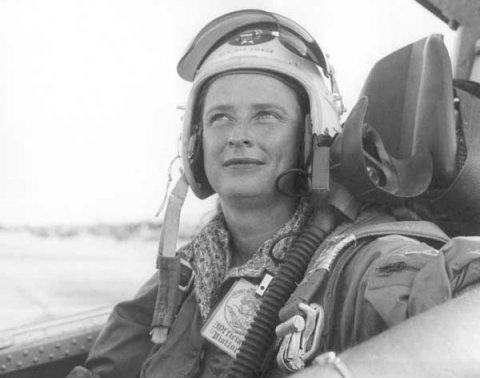Description:
Born in 1931, Geraldyn M. Cobb, known as Jerrie to family and friends, rose in the ranks of the male-dominated field of aviation to become NASA’s first female astronaut candidate. She was the first and only woman to successfully pass all three physical and psychological tests, resulting in her selection as part of the Mercury 13, a group of female candidates who trained in secret along with the original Mercury Seven astronauts. Powerful men and the social norms of the time, however, conspired to keep her from being the first woman to fly in space, an honor that went to Valentina Tereshkova, a Russian factory worker.
Hailing from Norman, Oklahoma, Cobb fell in love with flying when she climbed into the open cockpit of her father’s 1936 Waco bi-plane. She was 12 years old, and from that moment on, determined to pursue a career in aviation. It was an unusual choice for a young girl, and at times her resolve was tested, especially when told by her parents and others that “flying held no future for women.” But by the age of 19, Cobb had earned her private pilot’s license, her commercial pilot’s license, become a flight and ground instructor, and was teaching men to fly. At 21, she had the responsibility of delivering military fighters and bombers to different air bases around the world.
“I have this feeling that life is a spiritual adventure, and I want to make mine in the sky,” Cobb once said. With her selection as a member of the Mercury 13, Cobb seemed destined for the history books. In 1961, NASA appointed her as consultant to the nation’s space program, putting her one step closer to space. However, NASA’s requirement that all American astronauts have military jet test pilot experience effectively eliminated Cobb and all women from becoming astronauts since females were not allowed to fly in the military. John Glenn testified at a 1963 Congressional hearing that “men go off and fight the wars and fly the airplanes … the fact that women are not in this field is a fact of our social order,” diminishing the role of women as aviators. Further impeding her goal was then-Vice President Johnson’s scribbled response to a memo outlining the situation and Cobb’s impressive qualifications: “Let’s stop this now!”
Although it was a bitter disappointment, Cobb refused to be grounded. Instead, she put her talents to good use by flying medical, missionary and other humanitarian flights in South America, as well as surveying new air routes to remote areas, work that resulted in a Nobel Peace Prize nomination in 1981.
Cobb has set a number of records for speed, distance, and absolute altitude, and has been the recipient of many honors and awards, including the Amelia Earhart Gold Medal of Achievement, the Harmon International Trophy, the Pioneer Woman Award, and Pilot of the Year. In 1990, she was inducted into the Oklahoma Aviation and Space Hall of Fame.
Still in excellent condition, Cobb continues to fly professionally and hasn’t yet ruled out fulfilling her lifelong dream of space flight, pointing to John Glenn’s 1998 return to space at the age of 77.
“I’d give my life to fly in space. I would have then, and I will now,” she said.
Resources
Ackmann, Martha. The Mercury 13: the Untold Story of the Thirteen American Women and the Dream of Space Flight. New York: Random House, 2003.
Cobb, Jerrie. Jerrie Cobb, Solo Pilot. Sun City Center, Fla.: J. Cobb Foundation, 1997.
Cobb, Jerrie. Woman Into Space: the Jerry Cobb Story. Englewood Cliffs, N.J.: Prentice Hall, 1963.
“Jerrie Cobb.” NasaQuest: Female frontiers. 2007. http://quest.nasa.gov/space/frontiers/cobb.html
Lee, Victoria. Distinguished Oklahomans. Tulsa, Okla.: Touch of Heart Pub., 2002.
